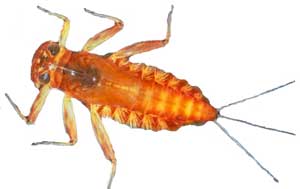Nutrition
The Etheostoma
zon ale species is a medium to large sized darter fish which
is why its diet differs from other darter species. Immature
aquatic
insects are mainly what has been found inside the stomachs of
the species, unlike the micro-crustaceans found in smaller
darters
(Cordes
1980). Specifically, the banded
darter feeds greatly on the larvae of the Chironomus
genus which has many different species
(Becker
1983). The orders in which you can find many of
the other insect larvae found in the diets of the species are: Diptera (flies), Ephemeroptera (mayflies), Coleoptera (beetles),
and Trichoptera (caddis flies)
(Becker
1983).
ale species is a medium to large sized darter fish which
is why its diet differs from other darter species. Immature
aquatic
insects are mainly what has been found inside the stomachs of
the species, unlike the micro-crustaceans found in smaller
darters
(Cordes
1980). Specifically, the banded
darter feeds greatly on the larvae of the Chironomus
genus which has many different species
(Becker
1983). The orders in which you can find many of
the other insect larvae found in the diets of the species are: Diptera (flies), Ephemeroptera (mayflies), Coleoptera (beetles),
and Trichoptera (caddis flies)
(Becker
1983).
Collectively, all darter species are considered "diurnal carnivores." This means that the activity level of when they feed is higher during the daytime and lower during the night. Since the species are quick, they have very accurate vision which helps them feed on moving prey (Cordes 1980). They also find their food by searching underneath rocks and pebbles with their snouts (Michigan DNR 2013). Some darters are particular in the insects they eat and they often leave potential food alone (Missouri Department of Conservation 2013).

